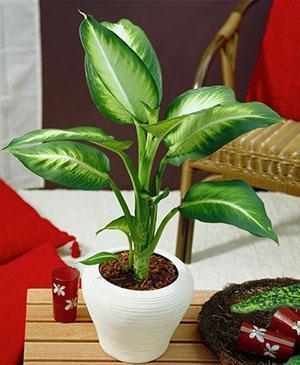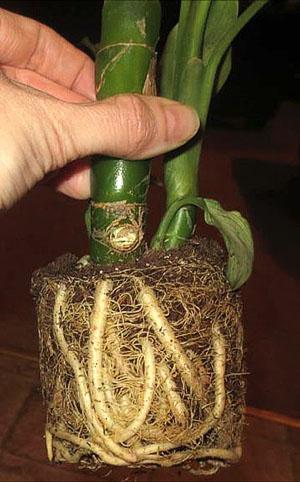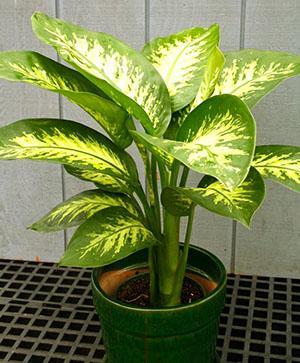Transplant and rejuvenation of dieffenbachia at home
 Due to the large foliage, decorated with a contrasting variegated pattern, dieffenbachia has become one of the most common indoor plants. If the conditions are right for the culture, it grows quickly, so the Dieffenbachia transplant is an important step in the care. The procedure will help not only to give the plant new strength, but also to rejuvenate the specimen that has lost its decorative effect.
Due to the large foliage, decorated with a contrasting variegated pattern, dieffenbachia has become one of the most common indoor plants. If the conditions are right for the culture, it grows quickly, so the Dieffenbachia transplant is an important step in the care. The procedure will help not only to give the plant new strength, but also to rejuvenate the specimen that has lost its decorative effect.
Perennial herbaceous Dieffenbachia is a native of the American continent. Crops growing in warm climates are often easily distinguished by their large leaf blades, strong stems and high growth rates. Dieffenbachia is no exception.
Florists who are seduced by the opportunity to decorate their home with a spectacular plant need to know that their green pet is not too willing to bush, and the stem growing up inevitably becomes bare.
It is possible to maintain the splendor of the foliage and the compactness of the crown with the help of competent care, during which the culture is subjected to both pruning and transplantation.
When and how to transplant Dieffenbachia? Does this procedure have limitations, and how can you make it easier for the plant to acclimatize in a new pot?
Dieffenbachia transplant at home

- slower growth rates;
- reducing the size of the formed sheet plates;
- rapid drying of the earthy coma after regular watering.
If you remove such a plant from the pot, it will be found that the roots have completely occupied the entire volume, and the substrate is practically invisible due to their interlacing. In this case, you need:
- pick up a pot with a diameter of 1-3 cm larger than the previous one;
- prepare fresh soil and material to replace the drainage layer.
Before transferring the plant into a new container, it is useful to inspect the root system.
With crowding or irregularities in watering, it often happens that some of the roots die off or rot. When they are promptly removed, there is no need to be afraid that after transplantation dieffenbachia will suffer not only from acclimatization, but also from infections developing in the soil.
Darkened from rot, weeping or, conversely, dry roots are carefully removed, and the cut sites are treated with fungicide and powdered charcoal. The green pet can now be transferred to fresh nutrient medium. This must be done in such a way as to preserve as much as possible the integrity of the root and earth coma formed during the growth. In this case, the period of getting used to new conditions will be as short as possible, and the grower will not be faced with falling leaves or other alarming symptoms of plant unhealthy.
 Transplanting dieffenbachia at home is carried out at the end of winter or early spring, when the plant has not yet entered the active growing season. The deadline when the culture can be fully and painlessly transplanted is the beginning of May. If circumstances force you to transfer the plant to a new container in the hot season, this should be done without disturbing the roots. It is better to use a new drainage for each dieffenbachia transplant. And the soil must be sterilized before filling into the pot.
Transplanting dieffenbachia at home is carried out at the end of winter or early spring, when the plant has not yet entered the active growing season. The deadline when the culture can be fully and painlessly transplanted is the beginning of May. If circumstances force you to transfer the plant to a new container in the hot season, this should be done without disturbing the roots. It is better to use a new drainage for each dieffenbachia transplant. And the soil must be sterilized before filling into the pot.
Young specimens are transplanted annually. These plants grow quickly, but are compact, do not need pruning and can be easily transferred to a larger container.
But how to transplant a dieffenbachia with a long trunk, when the foliage remains only at the top, and a tall unbranched shoot spoils the appearance of the plant?
Pruning Dieffenbachia Long Barrel
 In this situation, the transplant is carried out along with pruning. Sometimes the only growth point of dieffenbachia is at the very top of the stem. Aging, the leaves wither and fall off, and the trunk lengthens imperceptibly. Such plants:
In this situation, the transplant is carried out along with pruning. Sometimes the only growth point of dieffenbachia is at the very top of the stem. Aging, the leaves wither and fall off, and the trunk lengthens imperceptibly. Such plants:
- lose their attractiveness;
- need additional support;
- require more time-consuming care and attention.
But at the same time, dormant buds remain on the trunk in the nodes. If the plant loses its point of growth, they will have no choice but to wake up and give life to new powerful shoots, feeding on the already existing root system. Therefore, by cutting off the top of adult plants, you can quickly update an existing Dieffenbachia specimen, making it more bushy and lush.
The apical stalk and the bare part of the trunk are excellent material for the propagation of a houseplant. You can get cuttings for three- or four-year-old dieffenbachia.
How to renew and transplant dieffenbachia?
 It is necessary to cut the stem 1.5–2 cm above the node so that several viable buds remain to the ground level. The cut site is dried with a napkin and treated with a powder of activated or charcoal.
It is necessary to cut the stem 1.5–2 cm above the node so that several viable buds remain to the ground level. The cut site is dried with a napkin and treated with a powder of activated or charcoal.
In this form, the plant can be transferred to a fresh substrate. Before transplanting dieffenbachia, mix:
- two pieces of garden soil;
- a piece of crushed sphagnum moss;
- part peat;
- part of the washed sand.
Crushed charcoal can be added to the soil, and peat, if desired, can be replaced with soil from under coniferous trees.
 The resulting substrate should be loose and not too water-absorbing. If the roots of dieffenbachia, after transplantation or in the process of further growth, find themselves in a constantly moist dense environment, this threatens them with decay and inevitable diseases.
The resulting substrate should be loose and not too water-absorbing. If the roots of dieffenbachia, after transplantation or in the process of further growth, find themselves in a constantly moist dense environment, this threatens them with decay and inevitable diseases.
The bare stem and top with foliage remaining after pruning can be successfully rooted in a light sand mixture. Over time, the resulting cuttings will turn into the same beautiful dieffenbachia as their mother plant.
A video about transplanting dieffenbachia will help you understand the intricacies of this stage of caring for a tropical plant that has firmly settled on indoor window sills. After the plant has got into the new soil, it needs time to acclimatize. Therefore. Until the full growth of new leaves begins, Dieffenbachia is carefully watered and protected from direct sunlight. The culture does not need fertilizing for the first time after transfer to a nutrient substrate.